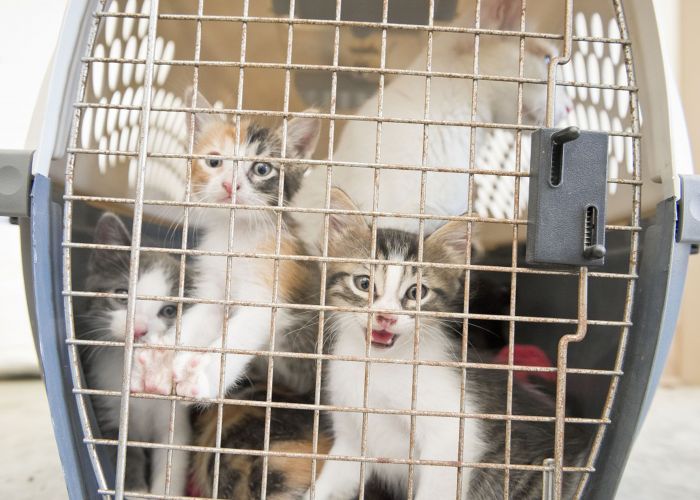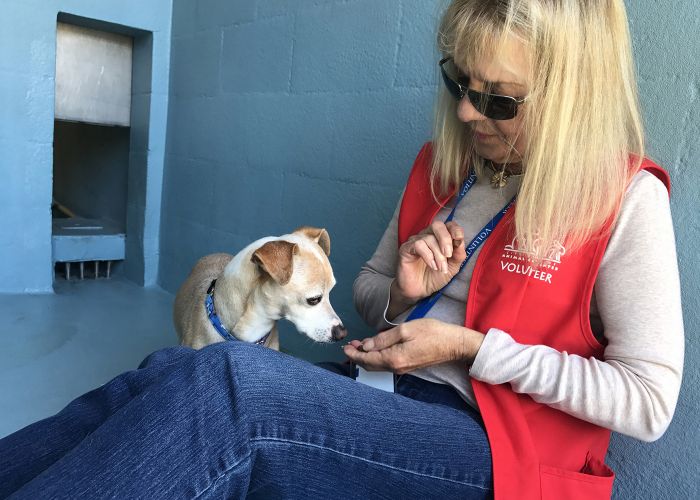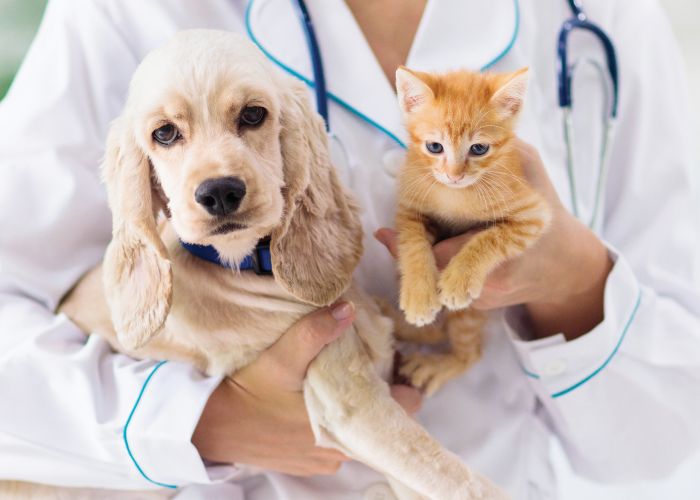Bunny days ahead
In many shelters, rabbit care is improving by leaps and bounds
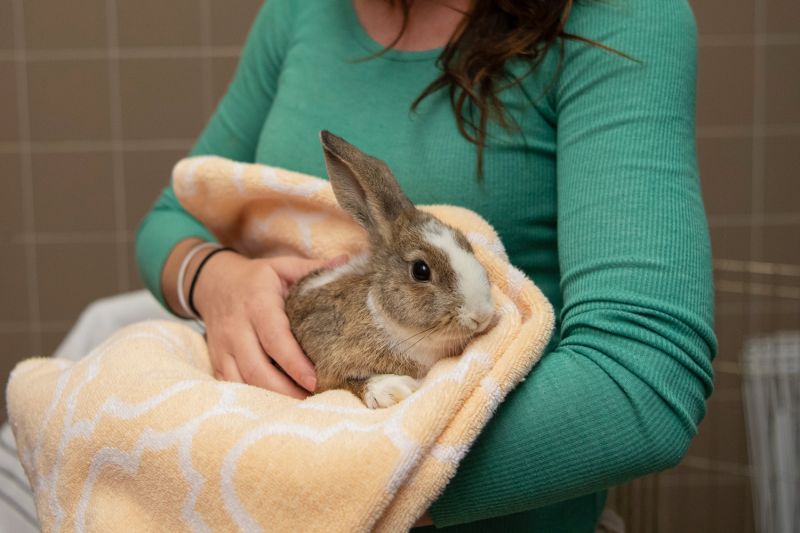
Editor's note: Since this article was originally published, a new variant of rabbit hemorrhagic disease virus, previously found in wild rabbits in Europe, Asia and Australia, was identified in pet rabbits in New York in 2020 and subsequently spread across multiple states. For information on vaccination protocols and other steps to protect pet rabbits from this deadly and highly contagious disease, visit the House Rabbit Society’s RHDV resource center.
Rebecca Kingery remembers the "old days" at the Animal Welfare League of Arlington in Virginia. Now an animal care technician at the shelter, Kingery started out as a volunteer in the 1990s, when rabbits languished in a small room at the end of a hallway, beyond the cat room and past the dog kennels. They shared tight quarters with birds, small mammals and the occasional stray chicken or piglet, and had no space for out-of-cage exercise. Because pre-adoption spaying and neutering weren’t the norm, hormones ran high in the rabbit room, which frequently led to undesirable behaviors and individual animals being labeled “cage crazy.” The rabbits didn’t get a lot of hands-on attention either, since most volunteers chose to work with cats and dogs.
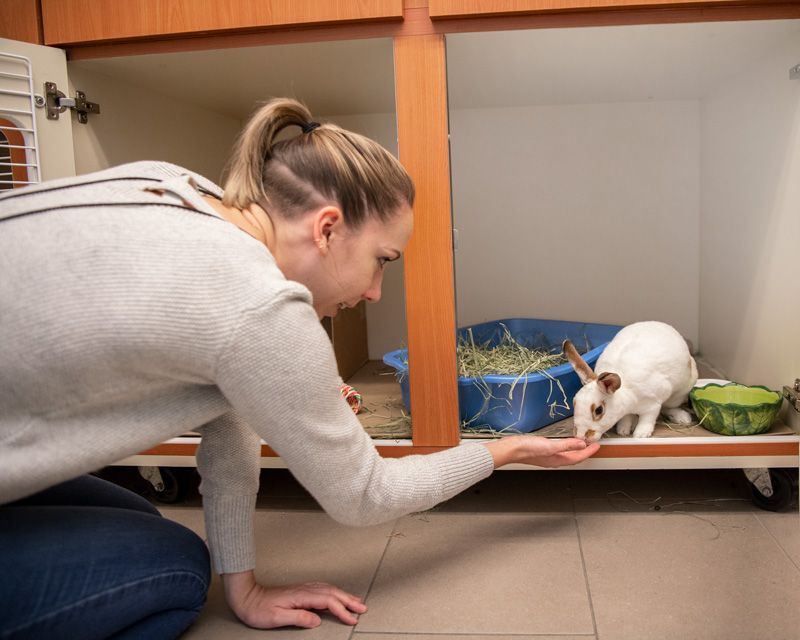
AWLA wasn’t an anomaly. That’s just how it was in the sheltering field then— overwhelmed with cats and dogs, shelters usually didn’t have much space, time or resources left over. And few staff members or volunteers understood rabbit behavior and needs. “It wasn’t a lack of caring on the part of people here,” Kingery says. “The knowledge just wasn’t readily available.”
Twenty years and two renovations later, much has changed at AWLA. Rabbits and small mammals are now in a spacious room off the lobby, well-positioned to catch the eyes of potential adopters. Spaying and neutering, modern cages and daily play time outside their enclosures are now standard. Again, AWLA isn’t an anomaly; the stepped-up program reflects an evolution in sheltering to ensure that rabbits receive the same quality of care and attention given to dogs and cats.
Of course, not every shelter has the ability to remodel, and bunny care is still on the back burner at some shelters. But as AWLA and other organizations have proved, adaptations can be made within every budget and facility to keep rabbits healthy, comfortable and adoptable.
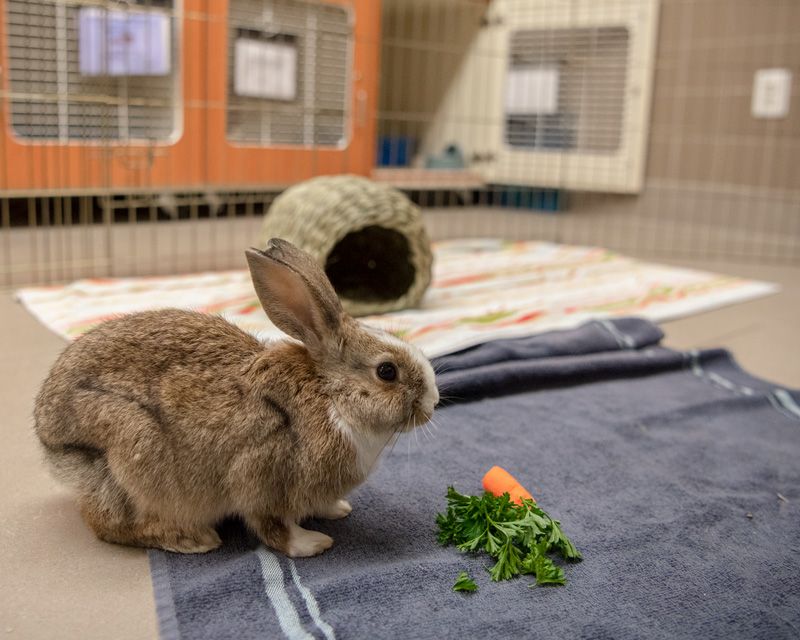
Rabbit hood
If your shelter is blessed with abundant space, housing rabbits in puppy exercise pens in a room of their own is ideal, says Anne Martin, executive director of the House Rabbit Society shelter in Richmond, California. The pens can be configured to fit the space, allow for easy cleaning, and enable staff to interact with the bunnies without having to pick them up constantly for cleaning or meet-and-greets.
In a smaller room shared with other small mammals, stacked cages make efficient use of wall space. The once-ubiquitous cramped, wire-bottomed rectangle is being discarded in favor of tiers of easily cleaned stainless steel or laminate surface enclosures. Dual-compartment cat condos with built-in shelves provide more space for play and allow the rabbit to be contained in one side during cleanup. A less expensive option is the Critter Nation cage, a multilevel wire high-rise with ramps that also works for ferrets and chinchillas, says Aubrey Clement, animal placement coordinator at Tacoma-Pierce County Humane Society in Washington.
If a wire rectangle is the only choice, however, be sure to prevent sore feet by covering the grid floor with something solid— linoleum, towels, woven grass mats, even cardboard. The minimum measurement for any type of cage is 30 by 30 by 18 inches; bigger is definitely better.
Cage accoutrements should include a plastic litter pan large enough for the rabbit to sit and turn around in, layered with a pelleted or shredded paper litter (available at pet stores) and topped with fresh hay to encourage litter box use. A spayed or neutered rabbit typically takes to using the litter box quickly, but if you observe urine and feces in a consistent spot outside the box, take the hint and move the pan to that area. At HRS, daily spot-cleaning keeps living spaces tidy, Martin says, and cages are disinfected between residents.
As prey animals, rabbits feel more comfortable having something to hide in. HRS provides small cardboard boxes with entrance and exit holes to give bunnies the security they crave as well as something to chew on. Since they can’t be disinfected, the shelter gifts the boxes to new adopters.
However your rabbits are housed, it’s important that they’re kept indoors. This protects them from predators and dramatic temperature changes, and it “communicates the right message to adopters,” Martin says. “We find that rabbits who live outside aren’t part of the family and their needs may go neglected.”
Adaptations can be made within every budget and facility to keep rabbits healthy, comfortable and adoptable.
Hip hop shape
In many ways, keeping bunnies healthy is easy compared to cats and dogs, says Martin. They don’t need vaccines or blood tests, and “there aren’t any major diseases that will be contagious between rabbits in a shelter or between rabbits and other animals. We don’t have to worry about rabbits catching anything except fleas.” [See editor's note above.]
Rabbits can develop upper respiratory infections, but they seem to spread far less between rabbits than they do between cats. URIs are easily treated with antibiotics, and quarantine is rarely necessary, Martin says.
At the HRS shelter, every incoming rabbit gets a physical exam, guided by a checklist that becomes part of the rabbit’s record. A thorough exam includes eyes, ears, nose, incisors, fur, skin, nails and feet. Revolution is safe for treating fleas and mites (never Frontline—it’s toxic to rabbits); HRS also treats new rabbits with ponazuril to protect against the coccidia parasite.
Poop patrol is an important part of monitoring rabbit well-being. Bunnies eat and defecate all day long, usually at the same time; a change in appetite or defecation is trouble, indicating potential illness or depression. “We do daily rounds with our rabbits,” says Clement. “I will literally look at everyone’s poo. If you’ve got cocoa puffs, that’s good; if you’re seeing brown rice, that’s telling me there’s something going on.” This can be a sign of stasis, in which the rabbit’s gastrointestinal system slows down or stops due to stress or poor diet; it can be fatal if left untreated.
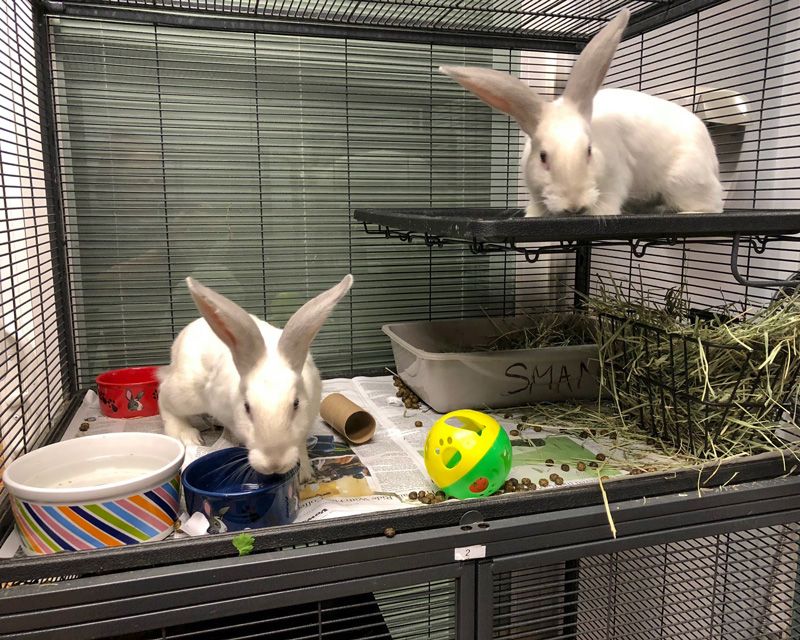
Keeping hormones in check
Just like with cats and dogs, spay/neuter carries significant health benefits for rabbits, guarantees that they won’t be producing unwanted litters and allows the animals to put their best paw forward with potential adopters.
Altered rabbits quickly learn to use the litter box (though they will continue to drop some fecal pellets as they hop to mark territory). This not only makes them more adoptable, but it also makes your shelter’s rabbit area calmer, cleaner and more pleasant for staff, volunteers and visitors. “My staff is always asking me when this one or that one is going to get fixed!” says Martin. For healthy bunnies who are old enough for surgery, “we try to get them fixed within a couple days of arriving because they’re so much cleaner.”
Male rabbits reach sexual maturity at 10-12 weeks, females at 4 months. That's when hormones take over, and cute little bunnies can turn into little monsters, spraying urine and making aggressive overtures to people and other rabbits. It’s all perfectly normal, but it’s hard to interest someone in adopting a pet who is displaying such behaviors.
Martin has seen many “problem” rabbits shed their bad behaviors within weeks after surgery. “It’s sad because those are rabbits that maybe would have stayed in their homes if their owners knew that spaying would have improved the personality,” she says.
In recent decades, sterilizing pets before they go home with an adopter has become a widely accepted sheltering best practice (and is mandatory for shelter cats and dogs in many states). It’s a best practice for rabbits, too, but while pediatric surgeries are considered safe for cats and dogs, surgery is riskier for young rabbits. Males can be neutered as soon as their testicles descend at 3½ to 4 months; females can be spayed at 4 months, although some veterinarians prefer to wait until they’re 6 months old.
Keeping young rabbits in the shelter until they’re old enough for surgery is impractical, so many shelters allow youngsters to be adopted before they’re sterilized, typically with deposits and follow-ups to ensure the surgery is completed. HRS makes the spay/neuter appointment immediately upon adoption and calls the new owner the day before to remind them. “We get the bill from the vet, so we know they showed up,” says Martin.

Building a bunny brigade
Even equipped with every luxury a pet could want, a cage is still a cage, and life inside one can get pretty boring. Time outside of the cage is essential for rabbits' mental health, and a strong volunteer program can be the key to making this happen.
Dan Hanley has been on the staff of the Peninsula Humane Society in Burlingame, California, since 2002, and he's witnessed the positive effect that regular enrichment has on rabbits’ well-being. “Now that we have rabbit volunteers that get them out on a regular basis, with fresh veggies and toys … they do much better medically and behaviorally,” says Hanley, director of animal adoptions and customer service. “They seem to be doing better in our care when we have more volunteer interaction.”
Bunny entertainment can be as simple as fresh untreated apple tree branches or cardboard toilet paper tubes stuffed with hay. Toys made of hard plastic, such as jingle balls for cats and rings of baby keys, are ideal for flinging and chewing (and can be added to your shelter’s Amazon wish list). Wicker baskets are also a good option, but avoid those from home stores, as they likely contain dyes and other chemicals.
“Hop time,” as it’s called at Tacoma-Pierce, consists of running around an x-pen filled with toys (bonded pairs can share a pen; otherwise the rule is one bunny per pen, as most rabbits are territorial). Peninsula Humane kicks it up a notch with Cottontail Cottages, which Hanley describes as glorified cardboard boxes with rooms and ramps that are placed in the x-pen. Amazon shipping boxes work, too, he adds, but the cottages are a good height and strength. “It’s nice to see their personalities come out,” Hanley says, “to see them be happy and hop around and express themselves.”
Experienced volunteers can also contribute to better bunny care by training shelter staff. “Even just getting staff members comfortable with handling rabbits goes a long way” toward improving their care, says Martin.
Volunteers have been the driving force behind the rabbit program at Tacoma- Pierce, says chief program officer Jocelyn Bouchard. “They came in many years ago with that knowledge and passion to ensure that rabbits weren’t treated like second-class citizens. … This organization was wise enough to really welcome that expertise and support.”
Along with providing daily enrichment for the shelter’s rabbits, the volunteers offer post-adoption counseling and workshops for novice bunny owners. Every Sunday, a “huge group” of volunteers shows up to do a deep clean of the shelter’s rabbit room and cages, trim nails, clean scent glands, groom bunnies and more, says Clement.
Outside the shelter’s walls, foster volunteers provide extra attention to ill rabbits, young litters and skittish rabbits who need a respite from shelter life. “They work magic,” says Clement, describing the “amazing” transformations she’s witnessed in behaviorally challenged rabbits after time in a foster home.
Leaping ahead
Unsurprisingly, shelters that have happy, personable rabbits who are marketed to the public experience more adoptions. “People come to our shelter looking for rabbits,” says Clement. “They’ve got great visibility on our website.”
At any given time, Tacoma-Pierce has about 50 or more rabbits in its care— about half of them in the shelter, a few in adoption cages at a local PetSmart and the rest in foster homes. Last year, the shelter placed more than 150 rabbits; this year, it's anticipating more than 200 adoptions.
Other shelters in the region have taken notice: Volunteers with Tacoma-Pierce have presented workshops on improving rabbit care to other organizations, and the shelter regularly takes in rabbits from shelters that are still struggling to place bunnies.
In Virginia, AWLA’s revamped program serves as a model for area shelters that are eager to improve their own practices. Staff members from the Fredericksburg and Fairfax SPCAs have visited to observe Arlington’s bunny housing and care.
A more knowledgeable staff and volunteer corps at AWLA also means that rabbits who would have once been deemed unadoptable due to behavior issues now have the time and space to regain their trust in humans.
That was the case for a feisty female named Orajita, who would lunge and bite at anyone who got too close. “She was as bad as a snapping turtle,” says Kingery.
To reduce her stress, AWLA placed Orajita in a floor-level cage. During exercise time and cage cleaning, staff placed an x-pen outside the cage door, allowing her to come out on her own time to explore. Patience and time won out, and Orajita turned into a sweet bunny.
Her adoptive family named her Maggie and is currently bonding her to another adopted rabbit. In the family’s latest update, says Kingery, Maggie can be seen cuddling in front of the television with her 9-year-old human sibling.


